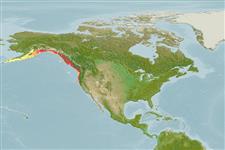| Native range | All suitable habitat | Point map | Year 2100 |

|
| This map was computer-generated and has not yet been reviewed. |
| Oncorhynchus clarkii AquaMaps Data sources: GBIF OBIS |
Length at first maturity
Lm ?, range 15 - 18 cm
Widely introduced into various streams and lakes within its natural range, as well as into a few lakes in eastern North America. In some streams it may be the most numerous sport fish present, while other streams support only small populations. At least 14 subspecies have been historically recognized (Ref. 5723).
Human uses
Fisheries: commercial; aquaculture: commercial; gamefish: yes; aquarium: public aquariums
Phylogenetic diversity index
(Ref. 82805)
PD50 = 0.5000 many relatives (e.g. carps) 0.5 - 2.0 few relatives (e.g. lungfishes)
Trophic Level
(Ref. 69278)
3.8 ±0.56 se; Based on food items.
Resilience
(Ref. 69278)
Medium, minimum population doubling time 1.4 - 4.4 years (tm=2-3; tmax=10; Fec=226)